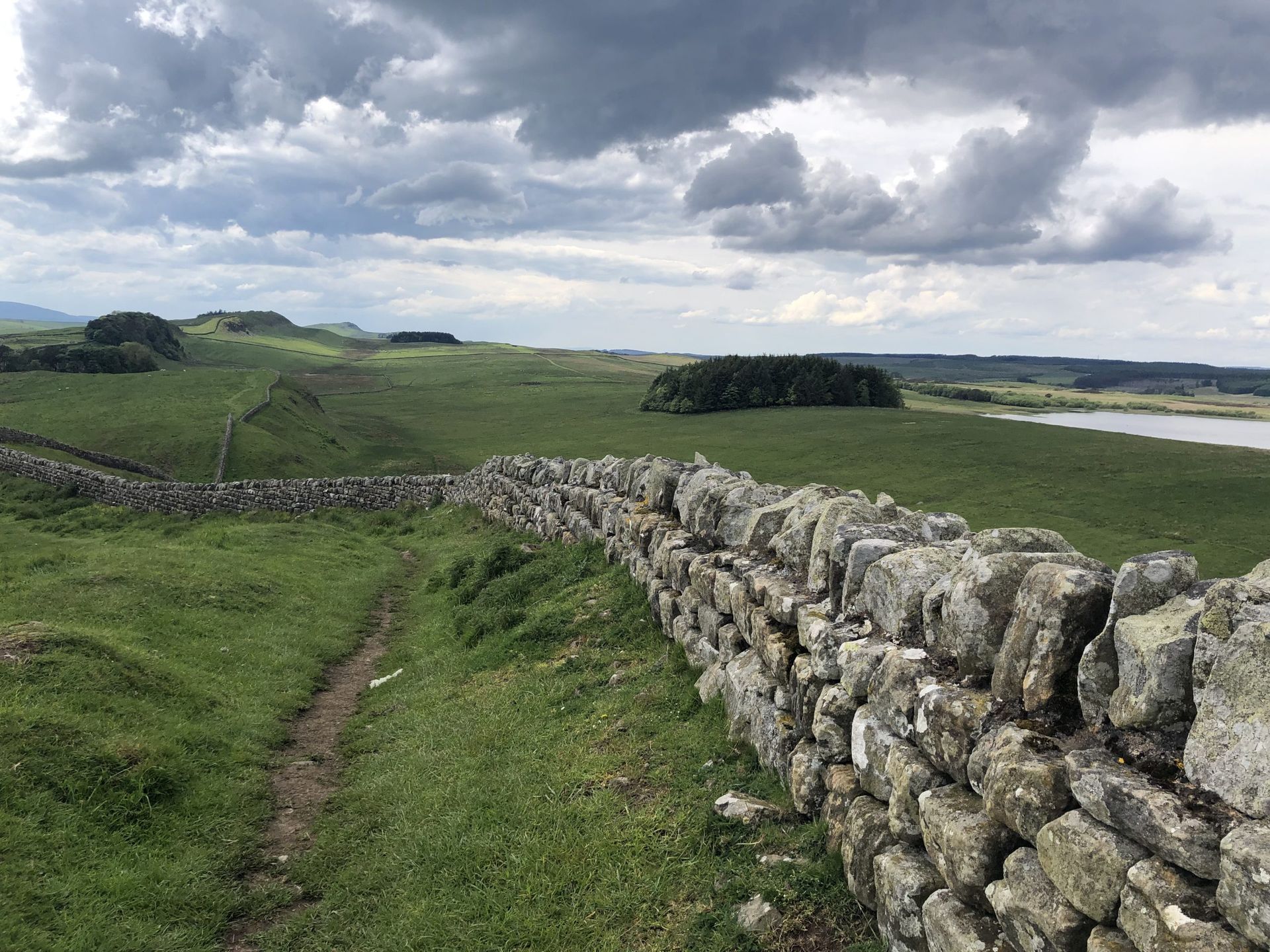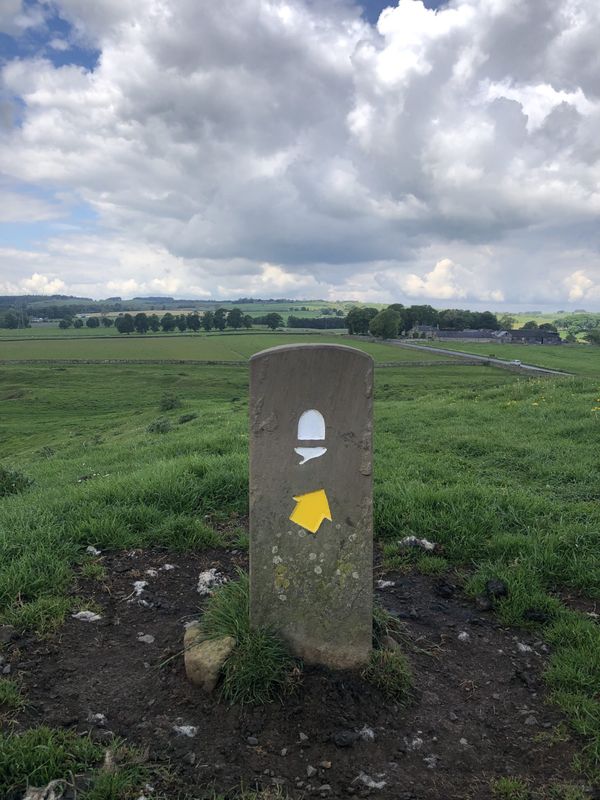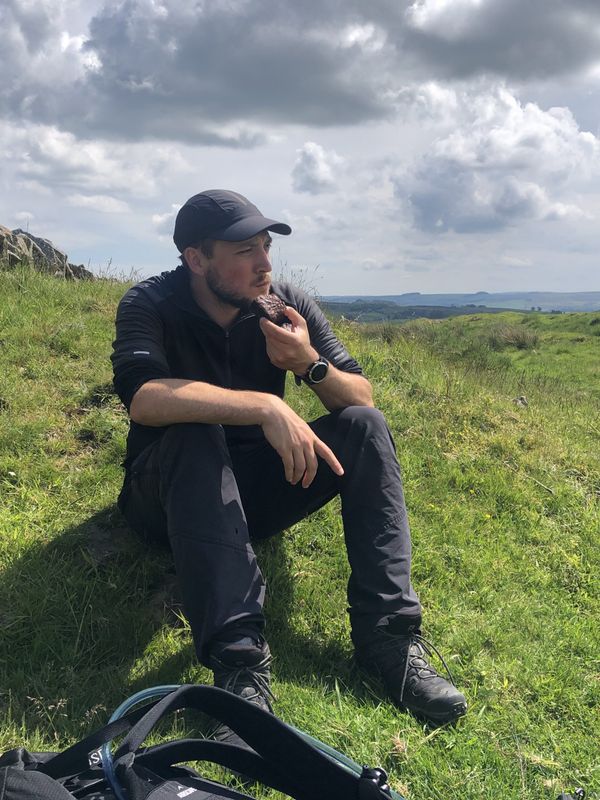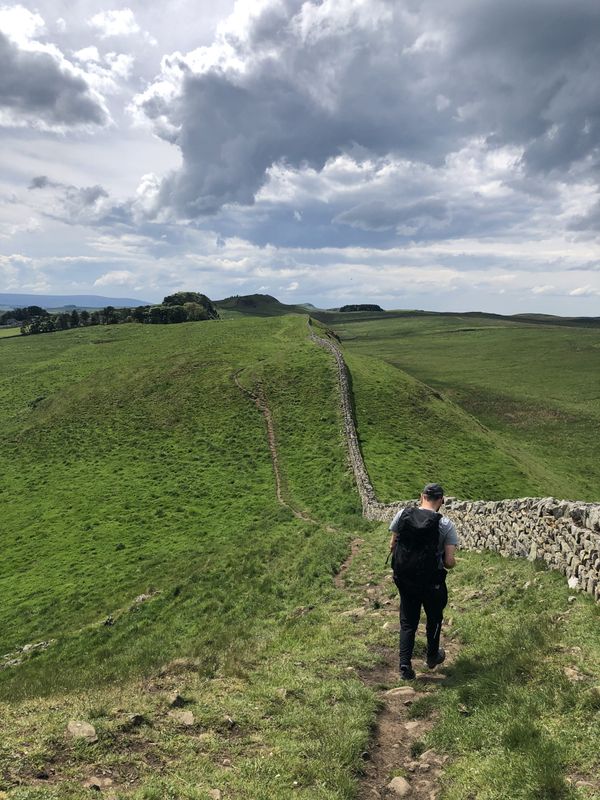A year before we took on this hike, while travelling in the North of England, we were curious to visit Hadrian’s Wall. The Wall was the north-west frontier of the Roman empire for nearly three hundred years, and was built by the Roman army on the orders of the emperor Hadrian in AD 122. At 117km (73 miles), it crosses northern Britain from Wallsend on the River Tyne in the East to Bowness-on-Solway in the west, and with parts of the Wall and forts still in tact it is one of the most historical places to visit in England. On our quest to learn more, we chose to visit Housesteads fort – the most complete Roman fort along the Hadrian’s Wall path. We spent a while wandering around the ruins, before coming out to a viewpoint where we could see the Wall stretching out over the undulating land as far as the eye could see. In awe of how beautiful this landscape was, I turned to Chris and absentmindedly said ‘Wouldn’t it be cool to hike the whole of Hadrian’s Wall?’ To which he replied ‘People do it all the time, there’s an official path’.
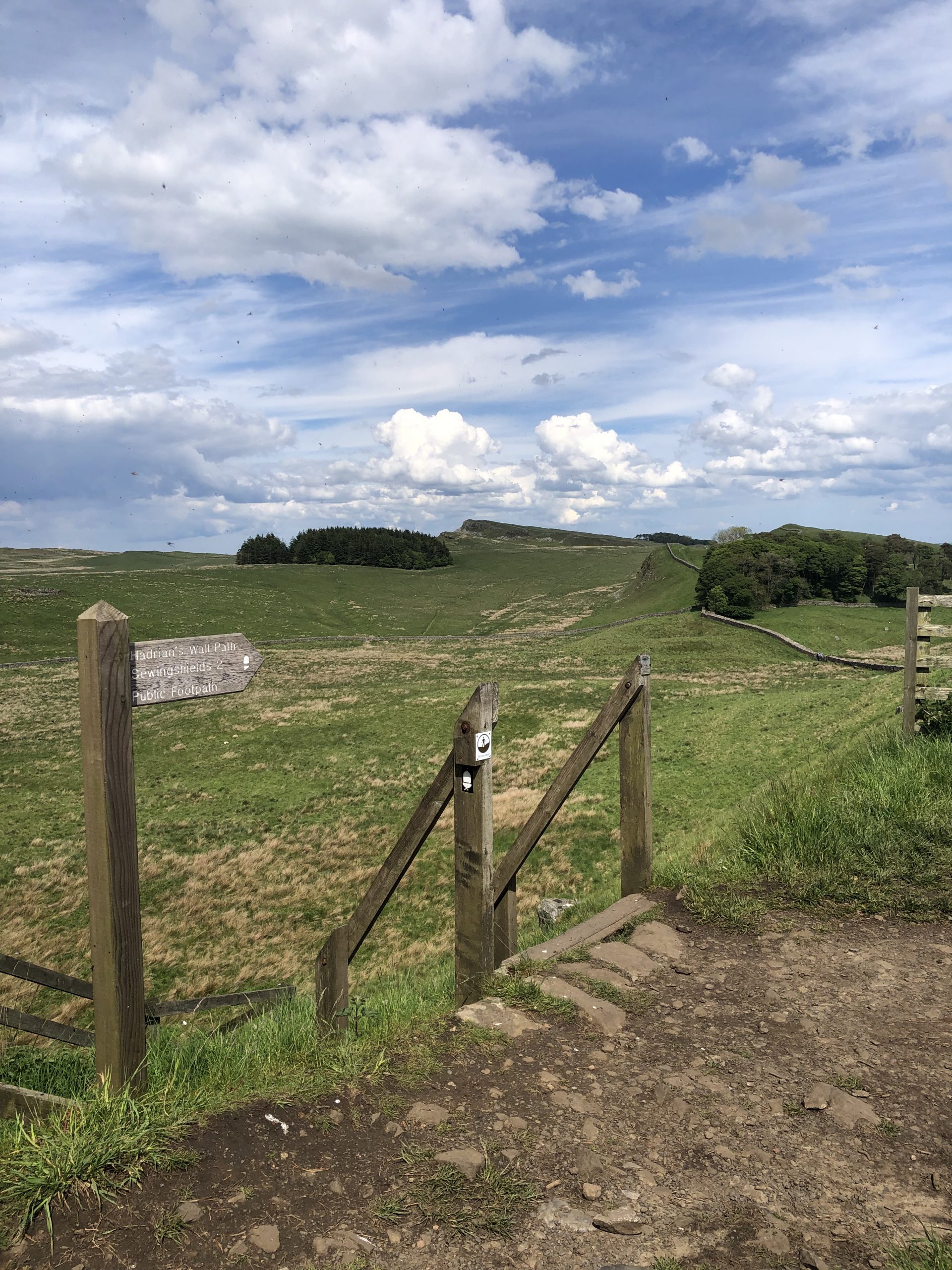
Minds full of Roman history and the seed for a hiking trip firmly planted, fast forward a few months and we were looking for a good physical challenge to undertake together. Remembering the gorgeous landscape we’d seen at Housesteads, this is how we came to plan a trip to hike the entire official Hadrian’s Wall path. Unbeknownst to us, by hiking the path in 2022 we were choosing to do so on the 1900th anniversary of its creation, making the trip all the more special.
Table of Contents
Decide your direction
We spent around four weeks planning our trip to walk the Hadrian’s Wall Path. While the path is well-trodden and incredibly well signposted, we didn’t go into this challenge lightly as we planned our rest stops, how many days we’d spend hiking the path, and prepped our gear so we could go into the hike confidently. We’d read recommendations from multiple sources to hike from West to East, though we couldn’t see a reason for this other than mentions of prevailing winds from the West making it harder if you’re hiking from the East. Ultimately, you’ll have to decide which way is best for you as both are just as scenic, and challenging! We began on the East coast in Tyneside, choosing to hike the extra 12km from the coast to where the Wall path begins in Newcastle, simply so we could say we’d walked coast to coast as the West end of the Path finishes right on the coast in Bowness-on-Solway.
To aid you in planning your trip, and to help you decide what you’ll need to make time for along the way, we have written other posts to accompany this one:
- Highlights on the Hadrian’s Wall Path. Here you’ll find our top recommendations for what to see along the Wall, and which sights are worth deviating from the Path.
- Our seven day itinerary. Details of every day of our hike, including what sights to see on each stage, where to find food stops, and accommodation recommendations.
- Where to stay along the Hadrian’s Wall Path. Accommodation is surprisingly scarce in certain sections of the Wall, where the Path passes through more rural countryside. Head to this post for more in-depth information on our top recommendations, as well as details of our experience and first-hand photos from each stay.
Invest in a guidebook
We have to admit, we’re usually more blog-reading, YouTube-watching kinds of researchers, but investing in a physical guidebook is our number one tip for those considering hiking the Hadrian’s Wall Path. Whether you’re planning to hike the entire path or just a section of it, we found Henry Stedman’s ‘Hadrian’s Wall Path’ guidebook to be an invaluable resource for planning our trip! Full of helpful tips, including where to look out for Roman ruins and hidden evidence of their presence, illustrated maps and suggested itineraries, we feel wholeheartedly that we would not have had such an enjoyable and relaxed time on our hike without investing in this book. While there are quite a few guidebooks available, this is the one that was most recommended when we were researching which to buy – not to mention, we saw it in the hands of countless other hikers when we were hiking the path! There’s a wealth of important information in this book, and it will save you so much research time when you’re planning your trip.

Gear up
Along the same lines as investing in a guidebook, it’s vital that you make sure you have all the equipment you’ll need and appropriate equipment at that! Take it from us – unless you’re planning to use a luggage haul company to take your bags from place to place for you, you’re going to want to jettison any unnecessary items from your backpack.
If you decide to camp along the way, consider what equipment you’ll need such as tents, sleeping bags, a cooking stove – and how carrying all this gear will impact your pace on the hike. We were thankful to have booked B&Bs and pubs along the way to have ensuite bathrooms and a nice comfy bed waiting for us each night, especially when we passed other hikers carrying huge bags and camping equipment on their backs. Booking B&Bs also meant that we could wash our quick-dry hiking clothes in the bathroom sink and put them on radiators to dry, meaning we didn’t need to pack as many items of clothing!
No matter where you’re staying, make sure you have all the usual appropriate hiking gear such as sturdy walking boots (that you’ve already broken in), first aid items such as blister plasters (trust us, you’ll need them!!) and depending on the time of year, items like sun hats, rain coats, and thin but insulated layers of clothing. You could also consider going on a practice hike in the weeks before you begin, as we did – we spent one afternoon hiking for four hours with our backpacks full of everything we’d need to hike the Hadrian’s Wall path. This was helpful in knowing what items we needed easier access to in our backpacks, understanding the importance of taking breaks to take the weight off your feet even if just for a few minutes, as well as getting used to hiking with a large backpack each.
We invested in a few new pieces of gear for this hike, first of all: water bladders. We are 100% sure we stayed better hydrated from having dedicated hiking bladders tucked into our backpacks than we would’ve done if we’d had to unscrew water canteens each time we needed a drink. As it was, we popped off the water bladder’s cap and drank from the tube connected to our backs – easy! We wouldn’t call it a requirement, but it definitely made staying hydrated easier.
We also only had one good quality backpack between us before this hike, so chose to invest in a second sturdy backpack with padded straps so we could comfortably carry our belongings between us. You’ll want to prioritise items that will make your life easier when you’re taking on long days of hiking – think good quality clothes that fold into tiny spaces, travel-sized toiletries, and a backpack with compartments that are easy to get into. You might also consider carrying lightweight flip-flops so you can change out of your hiking shoes once you reach your accommodation for the night, and give your feet a well-earned rest.
Tailor your trip to your needs
It might sound easy enough to just follow signs along a well-trodden path, but hiking for seven days in a row is completely different to taking on seven separate hikes. You need to think about how many kilometres you can realistically manage each day, depending on your fitness level and the amount of time you’re dedicating to complete the path. We spent weeks noting down places to stay, where to get food and water, sights we wanted to see, places where public toilets are available and marking places that would top up water supplies. We planned to complete the hike over the course of a week, and even then we had to cut out some of our planned sightseeing stops along the way. There is a LOT to see on this picturesque, historic hike – make sure you plan ahead well to avoid getting into stressful situations.
Consider the time of year
You may also want to consider the time of year that’s best for completing the hike. Caretakers of the Wall path ask the public NOT to hike the path in Winter, to allow the ground to recover from the heavy footfall it receives all year round. We planned our trip for the last week in May, making for a gorgeous Springtime hike where we only saw one day of rain, with the rest pleasantly overcast or sunny. It may also be worth checking out any events taking place – our hike coincided with school half term, as well as the week of the Queen’s Platinum Jubilee. This meant the middle section of the Wall was definitely busier than the East and West ends, especially around popular places like Housesteads fort as families took their children out for day trips. We found that pubs were busy too, though not unbearably so and we still managed to find a table wherever we stayed every evening (though the first evening of the Jubilee bank holiday celebration was a particularly lively one!).
Walking the Wall in Summertime will hopefully guarantee you the least amount of rainfall as you hike (though it is England so, you never know) but you can expect to see increased footfall along the Path and at the various points of interest along the way due to the school Summer holidays. In Autumn, you may find parts of the route wetter and muddier than in the Spring and Summer, but the changing orange foliage and sweeping Autumnal views throughout the countryside as you hike will more than make up for any inclement weather.

Write an itinerary and know where you’re staying
Even with four weeks of planning, a written itinerary and a daily list of sights to see, we still had to cut things out and change our plans. We’re grateful we made so many plans for this trip as it would have been ten times harder to think up contingency plans on the spot – especially when you’re physically and mentally tired from long days of hiking. We collated all our research from various blogs, our guidebook and YouTube videos into organised notes on our phones so we could refer back to them at any time, and by doing this made it easier to know exactly how far we were walking each day or how far it was until the next food/rest stop. You can find our day-by-day itinerary here.
We definitely pushed too hard on some days as we had to get to our next booked accommodation. One thing you’ll find about the Wall Path is the surprising lack of places to stay in some sections, mostly due to the fact that the path passes through some really rural areas. (We joked on multiple occasions during the hike that if we ever settle down in one place again, it would be lucrative to open up a chain of B&Bs in the tiny villages along the Wall path). A positive about booking B&Bs and pubs for our hike was that breakfast was included at every one. This meant that not only did we enjoy a comfortable night’s sleep in a proper bed each night, we also didn’t then have to find breakfast each morning, and most days we enjoyed a hearty full English breakfast to fuel us up for the day of hiking ahead. Most of the places we stayed would also make a packed lunch for the next day of your hike, for a small fee. Having your accommodation booked in before you embark on your hike takes one more thing off your mind as you hike the Path, and ensures you stay on track with your walk. Find our recommendations for where to stay on this post.
Honour the Hadrian’s Wall Code of Respect
Hadrian’s Wall has been around for over a thousand years, with original parts of the Wall still standing. Experts are still excavating artefacts and parts of the Wall itself, with work expected to continue for at least another two hundred years. The brickwork, while impressively hardy, should be treated with respect and as such UNESCO – the organisation who act as guardians of this world heritage site – created a Code of Respect that all hikers should follow when walking the path.
The number one way to respect the conservation of the Wall for future visitors is to never walk on top of it. It might be tempting to get a photo on top of Hadrian’s Wall, or just climb up to get a better view, but by doing so you could cause real damage. Similarly, while you should always follow the many signposts, it’s advised that you should walk beside the path, not on it, and never in single file if you’re in a group. Walking side-by-side gives the ground a chance to recover from all the heavy footfall it sees throughout the year. If you’re camping along the path, make sure it’s in an official camping site and do not wild camp along the Wall path.
If you’re like us and love spending hours hiking through the countryside, you’ll be familiar with the countryside code which also applies here; take any rubbish with you, close gates after you pass through them and, if you’re hiking with a four-legged friend, make sure they’re kept under close control for their safety (there are many, MANY cows and sheep along the Wall!).
A note about honesty boxes
While we’d recommend planning where to stop and eat each day to fuel your hike, we couldn’t write about the Hadrian’s Wall Path without mentioning the honesty boxes along the route – they made our day each time we came across one! These unmanned stalls and sheds are run by local people and families, offering refreshments in exchange for a small amount of money via an honesty system, where you leave the payment for your items in a cash box. It’s one of the reasons why it’s a great idea to carry a few coins on your hike – you’ll be supporting local families and there’s nothing like a cold drink or even an ice cream to keep you going on a hot day!
While some were small tables with homemade flapjacks and cakes, others were more established structures offering a wide range of food and drinks. Our favourite was the very well-stocked Newtown Snack Shed, where the owners have built a shaded picnic area on their driveway for hikers, and installed a microwave inside the shed with a range of meals provided! On this occasion we opted for a couple of cold drink cans and an ice lolly, though the variety of crisps, chocolate and cereal bars were very tempting.
Another great stop is the popular Laal Bite in Drumburgh, with a kettle for making hot drinks, a tap for filling up water bottles and a toilet too. We were excited to come across Matthew’s Honesty Box in Brampton, having heard more than a few recommendations for it, though we found it to be less well-stocked than others – probably due to its popularity. Haytongate Hut, just over 4km west from Matthew’s, had a nice selection of snacks with a kettle and multiple mini fridges, plus a portaloo for hikers and a merchandise shed selling Hadrian’s Wall t-shirts, hats and other souvenirs.
These small shops and sheds really fuelled us along our hike, both with the refreshments they provided and the warmth it brought to know that the locals want to provide support to hikers along their journey.


The Hadrian’s Wall path, while challenging to complete in one trip, is also one of the most rewarding physical challenges we’ve taken on to date! There’s nothing like hiking through the English countryside in Spring, when trees and flowers are blossoming and livestock frolic in the fields with their new offspring. For all our aching muscles and blisters on our toes, we found joy in spending hours each day just talking and enjoying the journey, admiring breathtaking scenery and collapsing into bed each night with a real sense of achievement. We’d highly recommend hiking the entirety of the path in one trip to truly appreciate the scale of the Wall and gain insight into Roman life. That being said, there are so many sights to see along this historical route so, even if you can only visit a small section at a time, it’s definitely worth it.
If you found this post helpful, please support our blog by donating as little as £1 to our running costs! Thank-you!

We are Chris+Suze
Related Posts

Hadrian's Wall Path guidebook
This guidebook was our most valuable investment when we hiked the Hadrian’s Wall Path. It outlines the entire route no matter which end you start from, and has handy maps and illustrations as well as details of campsites and BnBs. Highly recommend buying this book to accompany you if you’re hiking the HWP!

Klean Kanteen
We’ve owned Klean Kanteens for years – even before we started house sitting! Our bottles are still not showing any signs of wear and tear. They’re durable and lightweight, and can easily be clipped onto a bag when dog walking or hiking.

Garmin Fenix watch
We both have Garmin Fenix watches as we love to record all the dog walks, hikes, runs and other activities that we do! It’s easy to sync up this watch with your smartphone to analyse all the data too.

Thank you for reading!
We hope you’ve enjoyed this post! For more posts about hiking and great places to visit, head to our blog or follow us on Instagram and Facebook for photos and videos from our travels! Let us know in the comments – have you hiked the Hadrian’s Wall Path? Or has our post inspired you to go!
